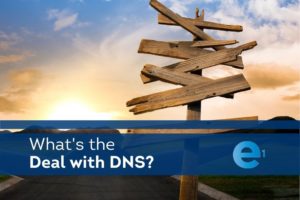We could make you the most stunning, user-friendly site, but no one will visit unless people know how to get to it. Welcome to the world of Website Hosting and DNS Records.
Think about it this way: if you want to host a party for folks at your new home, you will send them your address on the invite. That’s your domain. When your guests put the address into Google Maps, that’s your DNS Records. And when they show up at your house, that’s thanks to your Hosting and site files. You need all three (domain, DNS, and Hosting) to have people visit and interact with your website.
Sounds confusing? Don’t worry; you’re not alone. One of the most common questions we get during the website build process is hosting and making the needed DNS Updates. And with each Domain Registrar having a different setup, it can be confusing where you need to go to change or add DNS Records. Let’s break it down.
Website DNS Records: A Record and CNAME Record
Not all of your DNS records are created equal. When it comes to the DNS Records for your website, you will most often hear about the A and CNAME Records.
The A Record deals with your naked domain. What’s that? Your naked domain is the central part of your URL without the “www.” So, for us, it would be exposureone.com. It’s most often labeled with “@,” “A,” or “AAA.” If you’re unsure which your Registrar uses, keep reading or check your Registrar’s documentation.
The CNAME Record deals with the “www” version of your domain. It’s most often set to forward to the naked domain. This means if you type in www.exposureone.com, you will go to exposureone.com without the “www” displayed in the URL bar. Using the naked domain as your primary domain gives you a cleaner URL and guarantees if people type your URL without the “www” (which most folks do), they will find your site. The CNAME is often labeled with “CNAME” or “www,” depending on your Registrar.
How to Update Your DNS Records
Every Domain Registrar is slightly different, so we’ve compiled a few of the most common to get you the information you need to get your domain pointed.
GoDaddy DNS Updates
Once logged in to your GoDaddy account, go to the Domain Settings for the URL/domain you’d like to update. From there, to Manage DNS.
Once there, you will need to update the A Record (@). If you haven’t used your domain previously, the record will show as “Parked.” Click the Edit Button (a pencil) and replace the “Parked” with the IP Address provided by the Hosting Company. Click Save.
GoDaddy comes with the CNAME Record already set up to point to the A Record. But, if you find yourself missing the CNAME Record for “www,” click Add Record. Select CNAME, and create a new record with the Name: www and Points to: @
If you’d rather your Web Master or Web Designer make the updates for you, but you don’t want to share your login information, you can give the delegate access following these steps: godaddy.com/help/invite-a-delegate-to-access-my-godaddy-account-12376
Namecheap DNS Updates
Navigate to your Domain List Tab and click “Manage” next to the domain you want to update. From there, navigate to the “Advanced DNS” tab.
To create the A Record click on the “Add New Record” button. You will select the A Record Type with Host: @, Value: IP Address, TTL: Automatic. If you had your domain pointed previously, you should either update that record or delete it and create a new one.
To create the CNAME Record, click on “Add New Record” and add a CNAME Record with Host: www, Value: naked domain, TTL: Automatic.
Google Domains DNS Updates
Under the “My domains” tab, click “Manage” next to the domain you want to edit. From there, navigate to the DNS Tab.
When creating new A records or editing existing A records, you will keep the Hostname blank and update the following — Type: A, TTL: 3600, Data: IP Address.
For your CNAME Record, update the following — Hostname: www, Type: CNAME, TTL: 3600, Data: naked domain.
You can also send a collaborative invite to your Web Manager or Web Designer by following these steps: https://support.google.com/domains/answer/7179397?hl=en
Important DNS Considerations
DNS is touchy. We suggest if you are uncertain of the updates that should be made, reach out to your Web Designer. They can get collaborative access or your login information to make the needed DNS Updates.
If you do make the updates yourself, it’s essential you only edit the A and CNAME Records needed for your website. Leave any MX Records and your Nameservers alone. Making changes to those could interfere with your email and other functionality.
Remember that DNS Updates take time to resolve, sometimes up to 24 hours. So, if you make the update, don’t immediately expect to see the changes. It takes some time to update things on the World Wide Web!
Taking Your Vision Online
Designing and taking your website live can be a daunting task. But, it’s a task you’ll want to do — after all, everyone is online these days.
Luckily, we are here to help. Contact Exposure One today at 407-374-2924; we’re here to help you and your business thrive online.
